Gardening tips: how to plant a pear correctly
Pears enjoy a high level of popularity among many inhabitants of the planet. This is due to the fact that this fruit has many beneficial and nutritious properties.
Content:
- Description of the tree
- Features of grafting pears
- Pear grafting options
- Diseases of trees that are grafted
- Pear grafting tips
Description of the tree
Depending on the type of pear, it can be a shrub or a tree. In our country, the most common pear tree... Pear belongs to the genus of fruit and ornamental trees. The height of an "adult" tree is two meters or more.
Pear blossoms occur in spring (around mid-April). Depending on the variety of this plant, the pear can bloom both in early and late spring.
There are early ripening pears, the fruits of which ripen two months after flowering.
Many varieties of pears bear fruit in the fall, and their fruits can survive the whole winter. Depending on the variety of pears, the fruits can be of different sizes (from 100 to 700 grams). The tree begins to bear fruit a few years after planting.
This plant is quite resistant to environmental influences and does not require special care. It is able to survive both in the heat and in extreme frosts. The negative effect is only on its fruits.
Features of grafting pears
You can grow a pear from cuttings, but this is a very long process.
Grafting a tree is one of the most useful gardening techniques.
Thanks to this procedure the tree grows much faster and at the same time retains all the beneficial properties of the fruit. Also, this method is widely used for breeding new varieties of pears. Very often pears of different varieties are grafted, which makes it possible to develop a new variety with different taste qualities of the fruit. Also, a pear is grafted onto apple trees, which makes it possible to breed a pear-apple variety. The fruits of this variety look like an apple, but their taste is reminiscent of a pear.
Pear grafting is a rather complicated process that requires appropriate knowledge and skills.
To perform this action, it is necessary to use grafting material, which are cuttings, characterized by the presence of dormant buds. Also, for grafting a pear, you will need a garden tool such as a garden saw, garden pitch, budding knife and pruning shears. In this process, auxiliary materials are elastic tape or electrical tape, as well as plastic bags and film.
Before grafting a tree, an objective assessment of its condition is made:
- The crown of the tree should be perfectly formed, and its height should not exceed 4-5 meters.
- The growth of the tree should be about 30 centimeters per year.
- The lighting for the crown of the tree should be perfect.
- If the plant fully meets all of the above requirements, then you can start grafting it. Otherwise, it is necessary to carry out all the necessary work to correct the shortcomings of the tree.
- It is worth paying attention to the yield. If the tree does not bear fruit well, then you should not start grafting cuttings to it. Such a vaccination will not bring any results.
- Gardeners do not recommend planting trees that bear fruit at different times of the year.
- Often, such grafting leads to the death of the cuttings.
- Most often, pear grafting is carried out from a cultivated tree to a wild one.
If the gardener wants to get a stunted pear as a result, then grafting must be carried out on the quince stock.
This procedure will make it possible to obtain sweet and large fruits... Before starting to vaccinate, it is necessary to prepare all tools and auxiliary materials. This will allow the procedure to be carried out quickly and accurately.
Before vaccination, you need to have the following materials on hand:
- Cuttings.
- Copulating knife.
- One-handed saw.
- Insulating tape.
- Garden pruner.
- Polyethylene film.
- Garden var.
- Transparent plastic bags.
All auxiliary materials must be of high quality and the tools must be well sharpened. Fulfillment of this condition will help to quickly and efficiently carry out the vaccination procedure.
Pear grafting options
There are a lot of pear grafting methods and the most commonly used are:
- Simple copulation.
- Copulation with a tongue.
- Copulation in the split under the bark.
The easiest way to graft a pear is by copulating.
This requires:
- Initially choose the place for the rootstock and scion.
- The diameter of the pear branches at the cut points should be the same.
- Both branches must be cut with a knife at an angle of 30 degrees.
- Next, the stalk is connected to the cut branch on the tree and wrapped with plastic tape.
- Electrical tape is used to fix the tape.
- Sometimes gardeners use special plastic caps for fixing.
Copulation with a tongue is done in the same sequence. But at the same time, tongues are made on the cuts of the cuttings and branches of the tree, with the help of which the grafting elements are more tightly fixed to each other.
Copulation in the split under the bark is carried out:
- Only if the diameter of the cutting and the grafting site differ significantly from each other.
- This method is characterized by the minimum amount of trauma that can be caused to the rootstock.
- Excellent survival rate of cuttings is ensured due to rapid tissue healing.
- Bark grafting is characterized by a simple process. That is why it has gained a high level of popularity among gardeners.
- The disadvantage of this method is the poor fixation of the place where the rootstock and scion are held together. This makes it necessary to use a variety of strapping.
- Copulation for the bark requires cutting the cutting at an angle of 30 degrees.
- It is necessary to partially cut off the bark from the stock, under which the cutting should be inserted.
- Using plastic wrap, it is necessary to secure the stalk by wrapping the stock around it.
- The vaccination site must be wrapped with garden varnish. In the event that the stock has a large diameter, you can use two or three cuttings at the same time.
Split grafting is often used to graft an already mature tree.
This procedure carried out to rejuvenate the garden and increasing its resilience to climate change. Scion production is safe enough. This is because a mature tree has a strong root system.
Next, you need to make longitudinal splits in the stumps. If the stump has a large diameter, then two or three splits can be made at the same time. Next, you need to cut the cuttings in the form of a wedge and insert them into the splits. To align the cambium, the cleavage must be positioned to the bottom edge of the hemp. The vaccination site is protected with plastic wrap.
Diseases of trees that are grafted
Vaccination is not a painless procedure for a tree, it injures and damages it. Even with a high level of accuracy during grafting, the tree will survive stress. The tree is able to heal its wounds on its own. When the juice moves (especially in the spring), the cells of the cortex grow together, which contributes to the healing of wounds.
Often no additional human assistance is required for grafted cuttings to grow together.
But the gardener must watch the healing of wounds daily. When the need arises, a person needs remove wild growth and monitor the correct formation of the crown.
In order to protect the tree from the development of diseases, before grafting, you need to make sure that neither the scion nor the splitting have any diseases. Plants must be observed throughout the year. Nutritional deficiencies should not be confused with viral disease. If you have any doubts, then it is better not to vaccinate.
It is worth remembering that viral diseases of pears appear at the beginning of the growing season.
Their manifestation is significantly weakened by the middle of summer. Nutrient deficiencies are most noticeable in the middle of summer. If you remember these two rules, then it will be quite difficult to confuse illness with a lack of nutrients.
Pear grafting tips
After grafting, you must leave a tag on the handle:
- It should not be removed until the stalk is completely engrafted.
- The tag clings in order to navigate the situation.
- If the vaccination is successful, then it is safe to repeat this process the next year.
In order for the cuttings to take root better, you need:
- Pieces of moss must be placed in insulating bags.
- With this action, the cuttings will feed on moisture, which will contribute to their rapid engraftment.
- Use special tools to insert the stalk into the cleft. This will greatly simplify the pear grafting process.
- To increase the absorbed surface of the cuttings and the branches of the tree must be cut at an angle of 30 degrees.
- Most often, the grafting is successful when a pear stalk is attached to a pear or hawthorn.
- When the first leaves appear on the handle, you must immediately remove the film. This will allow the cutting to breathe, and the graft site will heal much faster.
- If shoots appear below the grafting site, they must be removed. This will give the tree much more strength to heal the graft site.
- If necessary, you can carry out panning of the increments. This action is carried out in the middle of summer. It consists in removing the upper non-lignified part of the shoot.
- It is also necessary to remove the bandage from the shoot in a timely manner. Otherwise, she may crash into the escape. An eyepiece knife is used to remove the strapping.
In whatever terms the vaccination is made, the stalk must have kidneys. It is best to carry out this procedure in the spring.
Grafting pears is a difficult and troublesome process. This action must be performed very carefully with a high level of accuracy. The more accurately this process is performed, the more likely it will be successful.
The grafting procedure can be roughly divided into three stages:
- The first of them includes the preparatory stage, at which the gardener must track the presence of diseases in plants.
- The second stage is directly copulation.
- The third stage includes tracking the growth of the cutting and removing the film from it. With the correct passage of all these stages, you can achieve the desired results. That is why the gardener needs to be patient, and the result will always please him. After all, with the help of grafting, you can not only bring out new varieties, but also significantly rejuvenate your garden.
More information can be found in the video.



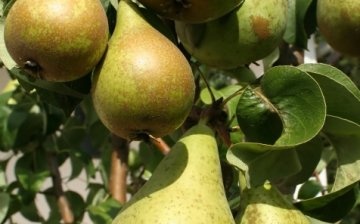
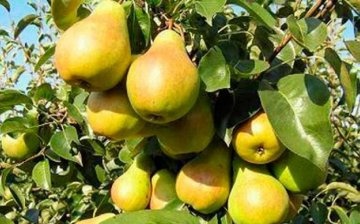

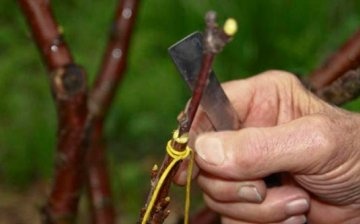
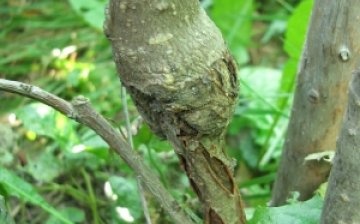
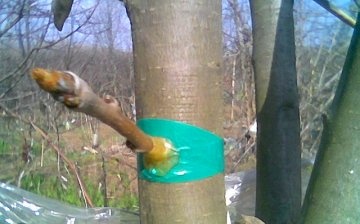







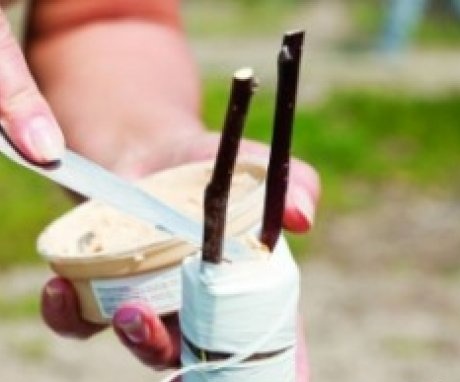
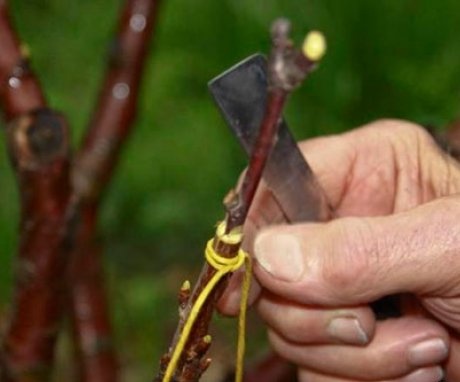

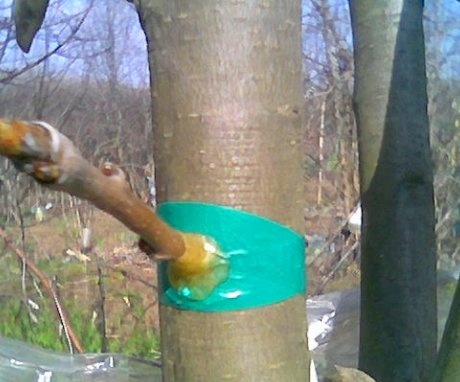
Are they vaccinated in the spring? Our pears are very tough, and if you pick and put them, they melt brown inside, soft, but not sweet, they knit anyway. Let's try to vaccinate.